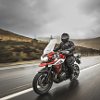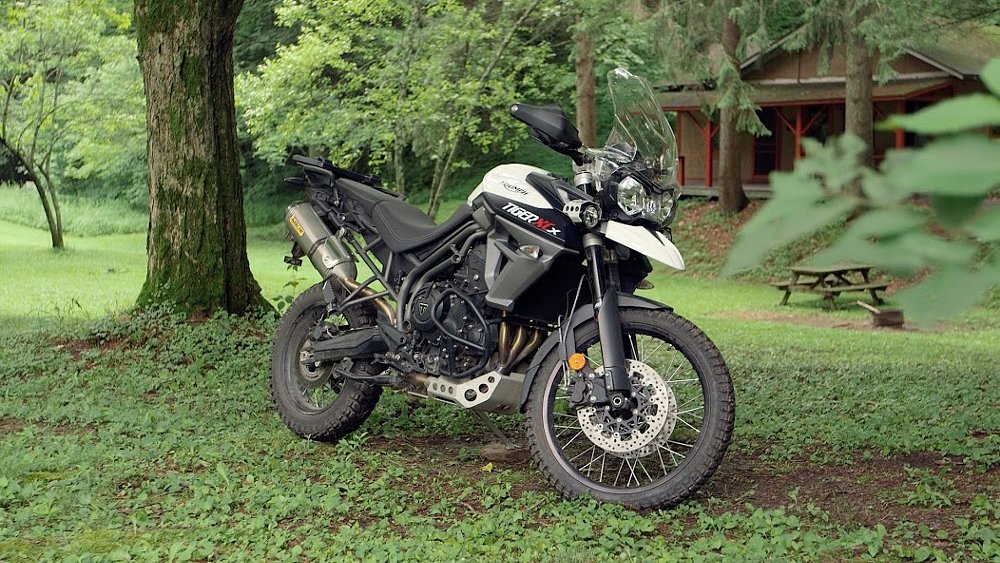Imitation, of course, is the sincerest form of flattery. So, I have no doubt moto-journalist Alan Dowds will be gladdened to know I have stolen his idea.
“I’m planning to do 1,200 miles on the 1200,” he told me, as the two of us enjoyed whiskys after a day of riding the new Triumph Tiger 1200 in Scotland’s Loch Lomond and the Trossachs National Park.
I immediately decided I’d do the same, despite not really needing to. I own a 2017 Triumph Tiger Explorer — the previous generation of Tiger 1200 but with a different name. This latest iteration is the third generation of big Tiger, the first existing from 2011-2015, the second from 2016-2017. In terms of look, chassis, and engine, the differences between Gen 2 and Gen 3 are pretty nominal.
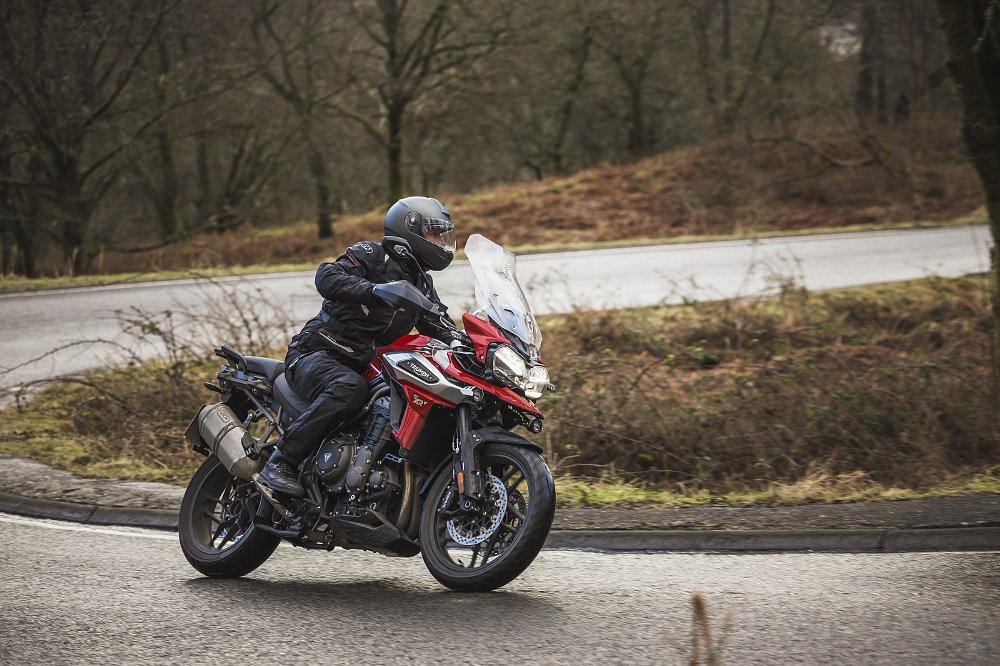
So, I already knew that the Tiger 1200 is a fantastic road bike. Within just a few miles, I was able to confirm it has lost none of the things I love about my own bike. It goes stupidly fast when you want it to, it drones on interstate/motorway when you need it to. It is comfortable, offers roomy accommodation for a passenger and, when equipped with accessory panniers and a top box, hauls the same amount of stuff as the new Honda Gold Wing.
But hey, man, it’s a motorcycle. And motorcycles are made to be ridden — especially this one.
The first 170 miles or so of riding was done in the aforementioned national park, located about 30 miles north of Glasgow. It is where the Highlands begin, offering postcard-worthy scenery at every turn. It is also — due to its being located in Scotland — almost always wet and cold. When I arrived for the ride I was handed a set of Triumph-branded thermal underwear.
That came in handy when the “warm Scottish rain” that fell throughout our ride turned to snow at higher elevations. The Tiger 1200’s new larger touring screen was also much appreciated in those adverse conditions. Still electronically adjustable, it now pushes air to the very top of my six-foot, one-inch frame. That’s an improvement over the screen on my bike, but I remain annoyed at the lack of aftermarket screen options. (Looking at you, Givi. Where’s my Airflow?) Meanwhile, heated grips and heated seats come standard on the top-end XRT and XCA models, with both features now being activated via fancier buttons.
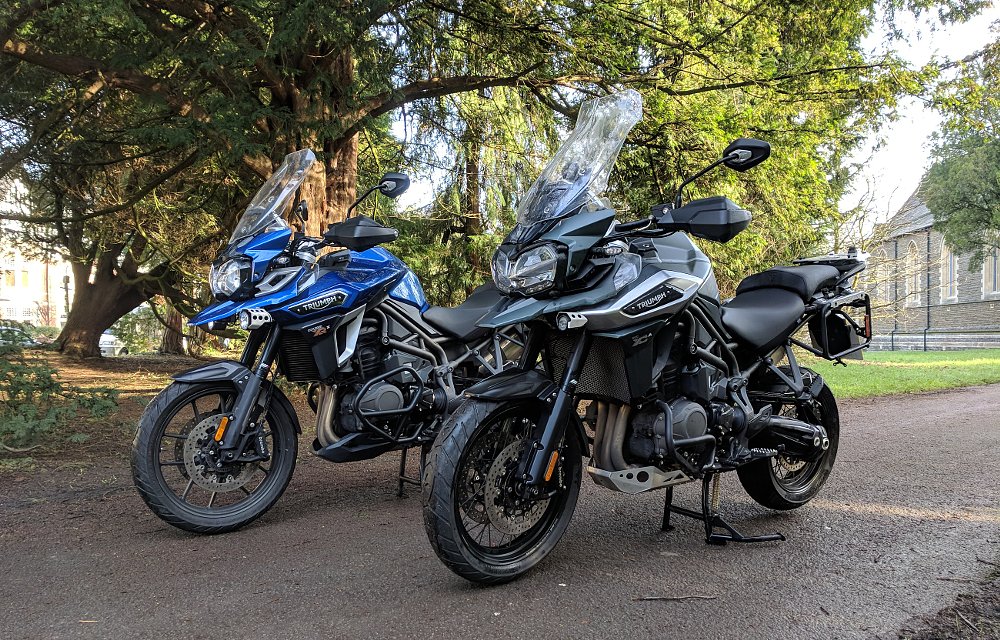
“Now with fancier buttons” is the concise review of the Tiger 1200. In terms of looks, you’ll be hard pressed to spot the difference. Side by side, the new bike’s fairing appears to be oh-so-slightly less wide, but the Triumph people assure me it isn’t. It’s just shaped differently and its fittings are reportedly of higher quality. I hope that latter claim proves true; it would be nice to know future Tiger 1200 owners would not suffer wind deflectors snapped by kamikaze bumblebees (yes, I hit that bumblebee at 100 mph, but still). The biggest aesthetic difference comes in the new headlights, more on which in a moment.
The other 1,000-plus miles I put on the bike were spent traveling 450 miles of motorway to my home in Cardiff, 300 more miles of motorway zipping to London and back, and the rest on a handful of runs through the winding roads of Brecon Beacons National Park. Had I not already known how the bike would perform, these jaunts would have told me all I needed to know about its abilities.
You’re probably aware that Triumph splits its Tiger 1200 line into two variations – XR and XC – with further subcategories adding the XRX, XRT, XCX, and XCA models, as well as a lowered version called the XRX LOW. It’s a confusing alphabet soup. The CliffsNotes version is that XR models have cast wheels, XC models have spoked wheels, and the final letter simply lets everyone know how how much you paid for your bike. The more you pay, the more bells and whistles you get.
In my case, I rode the XRT during the initial ride in Scotland and rode home on an XCA. Those are the top models in the lineup, both topping $21,000 in price in the United States.
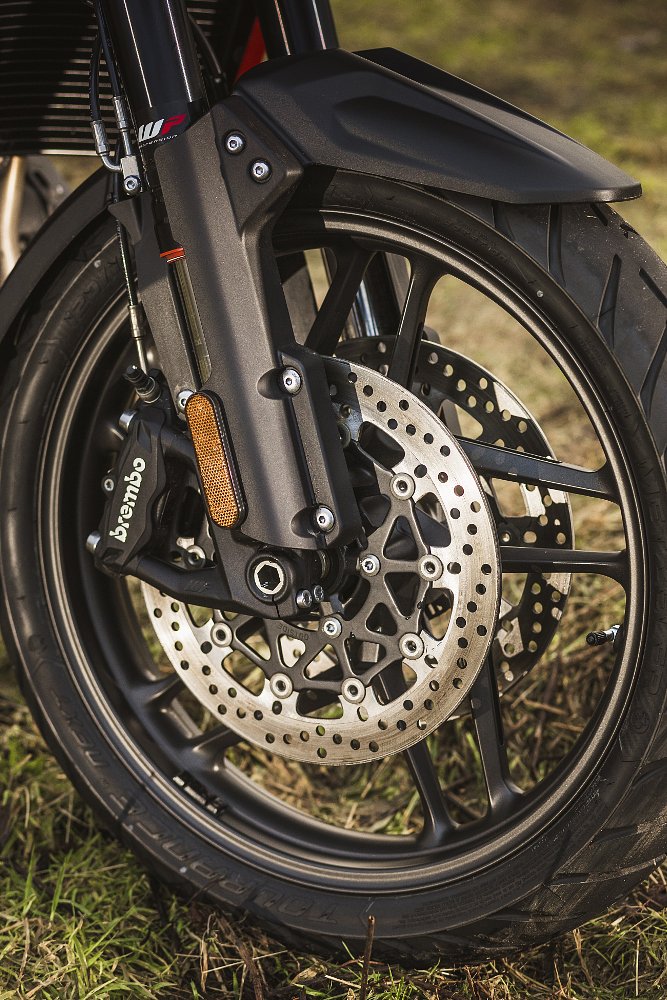
Tweaking the Triumph Tiger for 2018
All Tiger 1200 models are powered by the same tractable 1,215 cc inline triple that the company’s been using since 2011. Triumph has the magic touch when it comes to triples and the Tiger 1200’s powerplant is a prime example: it’s a delight. The engine has, of course, been subject to a fair bit of tweaking across the different generations. It now puts out a claimed 139 horsepower (two more ponies than the previous generation), and although you have to rev higher to hit peak torque (90 foot-pounds at 7,700 rpm vs 90 foot-pounds at 6,200 rpm on my Gen 2 bike), the torque curve is noticeably broader.
The bike’s throttle is more responsive. Perhaps another way to phrase this is that Triumph has managed to work out the kinks in its ride-by-wire system. There’s a little more V-twin-like urgency when screaming out of corners, but it retains the mercury smoothness of a triple when ridden more sensibly. The 2018 Tiger 1200 builds upon the why-can’t-everyone-else-do-this slickness of the Gen 2 gearbox. The top-end XRT and XCA models come equipped with a “Triumph Shift Assist” quickshifter, which works pretty well, though I question the need for it since clutchless upshifts are already so easy.
Paying for the XRT or XCA will also net you a fancy Arrow exhaust. Some 4.6 pounds lighter than my bike’s anemic, Howitzer-sized can, it delivers a more dirt-bikey, menacing note. That said, you lose some of the traditional bark of a triple at high revs, so your aural satisfaction may vary.
I’m not a terribly fast guy, but in Scotland I got stuck chasing after a pack of them — pushing the Tiger 1200 hard enough through twisting and undulating roads that clouds of steam were coming from our tires when we stopped for lunch. In all that riding, the bike was far more settled and planted than you would ever imagine possible from such a tall, heavy machine. Partial credit, of course, goes to the stock Metzeler tires, but equally you can’t help but be impressed by the improved Triumph Semi Active Suspension (TSAS).
The TSAS system controls front and rear damping, as well as preload. It is constantly making little adjustments as you ride, according to load and conditions. Within this, there are nine selectable levels of comfort. On Gen 2 bikes, the system works more in a philosophical sense; I’ve tried all the settings and honestly cannot tell one from the other. This is less the case on the Tiger 1200. It is still not as obvious as the settings on a BMW with a similar system, but I can actually tell the difference between Comfort and Sport now.
That said, the bike will still get unsettled if you attempt to come down particularly hard from excessive speed. Say you’re riding along at 125 mph and it suddenly occurs to you that a cop might be hiding in those trees up ahead, so you bang on the Brembos to halve your rate of progress in an instant. In this scenario, the bike can be just a smidge squirrely. Of course, the obvious solution is: don’t do that. Either scout your roads better, or stop riding like a jerk.
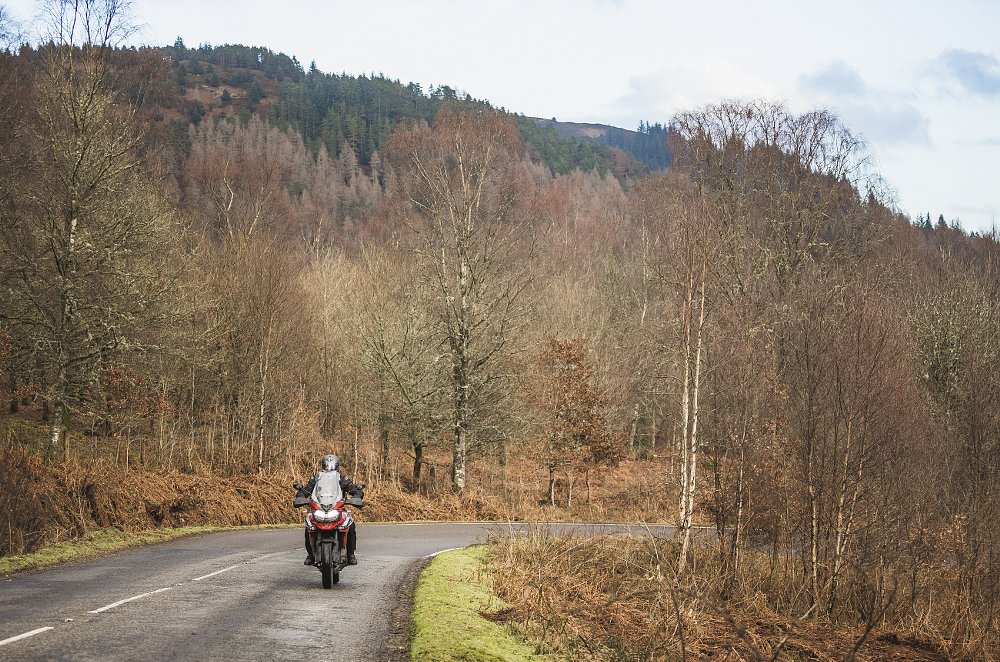
Fortunately, the Tiger 1200 is perfectly happy to entertain your old man side as much as your inner hooligan. The bike remains all-day comfortable. Triumph says it has moved the handlebar closer but I didn’t notice. An excellent cruise control system comes standard on all models and the switchgear for it has finally been moved to the left grip, where cruise control switchgear should be. Fuel economy remains somewhat disappointing, however. You will not make it 200 miles from the 20-liter (5.2 U.S. gallons) tank before seeing the Fuel Light of Doom.
Where the Tiger 1200 really vindicates the new higher price tag is in its dizzying electronics package. While the Gen 2 Tiger Explorer was already loaded with technowhizzbangery, it’s now better and slicker. Maybe a little too much better. With my bike, I can have traction control on but enthusiastic acceleration will still be rewarded with a gentle lift of the front wheel — a wheelie for dudes unsure about doing wheelies. No longer, though. You can crack the Tiger 1200’s throttle hard as you like and that front will stay glued to the ground. (The brave, though, can still turn traction control off.)
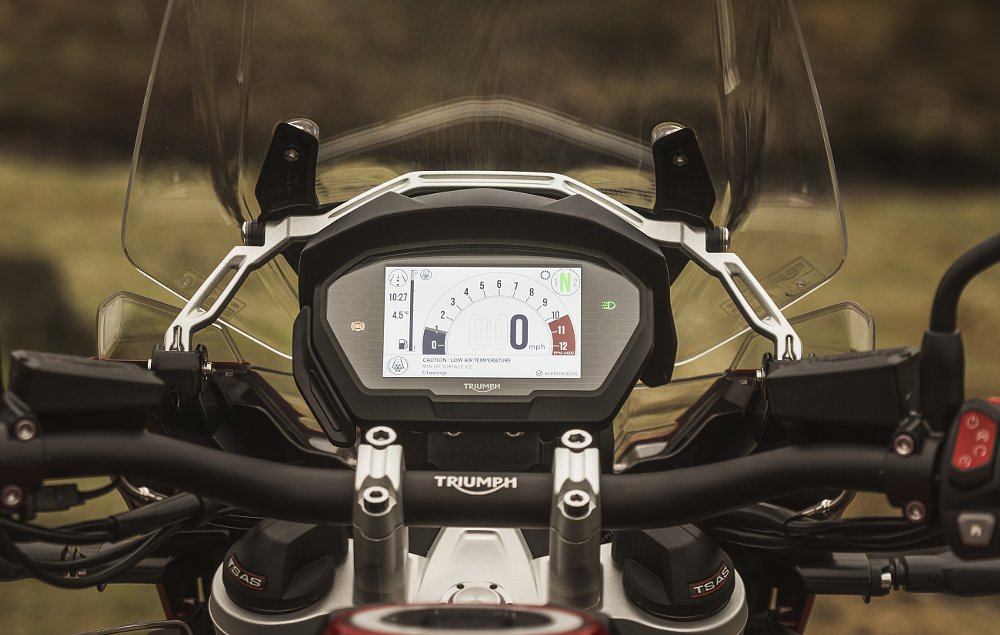
How you interact with most of the bike’s bells and whistles has changed dramatically. The Tiger 1200 has a sexy five-inch TFT display screen so loaded with information that I recommend taking 45 minutes to click through everything before getting underway. Otherwise you’ll find it difficult to keep eyes on the road
The means of navigating this information has also changed, with Triumph implementing the same handlebar joystick — aka “switch cube” — introduced on the Street Triple last year. My initial reaction to the joystick was something along the lines of “do not want,” but it turns out to be more intuitive than I imagined. It’s certainly easier to figure out sans handbook than the navigation system on Gen 2 bikes.
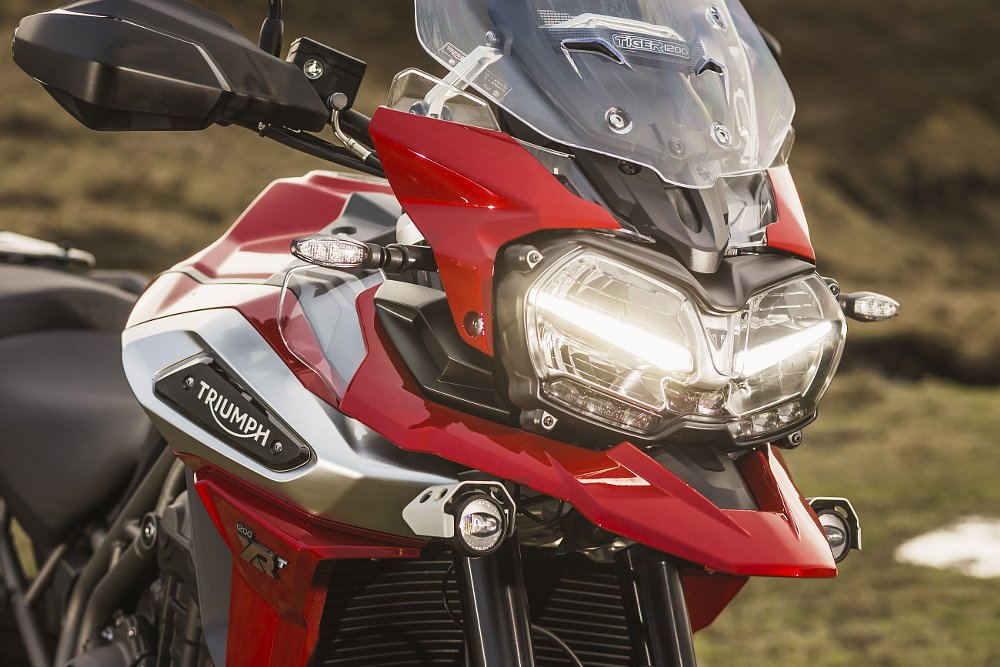
And, of course, there are the fancy headlights. Making the Tiger 1200 look just a teeny bit like a Ducati Multistrada when viewed in a side mirror, the new LED lamps throw more light and draw more attention than beams of old. More importantly, however, they are lean-sensitive, putting a touch more light into corners. I tested this feature on a number of dark Welsh evenings and have to admit I didn’t really notice a major difference compared to the amount of light thrown when upright, but, hey: more light is more light.
What about the Tiger in the dirt?
You might have noticed I’ve not said anything about the Tiger 1200’s off-road ability. This is because you shouldn’t take it off road. Personally, I’m fine with that. Bikes with a starting price of $16,500 (running to $21,750 for the big XCA) should not be flung at rocks. This one in particular; it’s too top-heavy.
The Tiger 1200 is not and never will be the BMW R 1200 GS that it’s emulating (right down to complicated navigation system, DIN sockets, and we-haven’t-finished-working-on-it aesthetic). Triumph claims the new XCA is now better off road, but whatever electronic improvements have been made are negated by the fact it is still very heavy and its weight poorly placed for off-road application. The XCA weighs 548 pounds dry, which works out to something like 595 pounds when full of fluids and fuel. That’s pushing Harley territory, son. True, an R 1200 GS is hardly a featherweight, but the Bavarian machine keeps its poundage low. Bulk on the Tiger 1200 is worn up high, making it droptacularly challenging to muscle around on uneven surfaces.
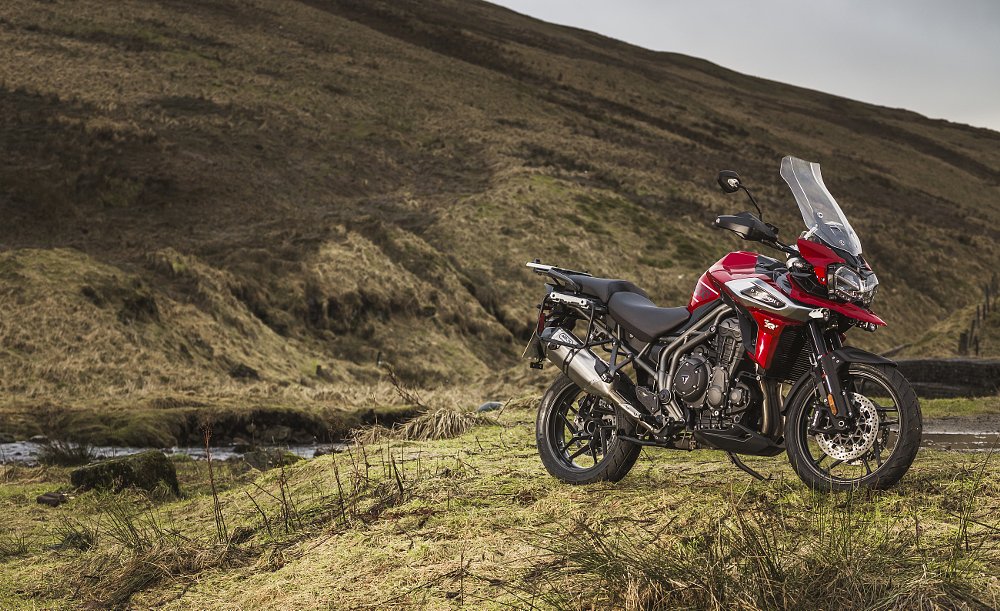
Don’t confuse all this for criticism, though. I love the Tiger 1200. I’d just like to see Triumph abandon its off-road ambitions for this machine. On the road, it is vastly superior to an R 1200 GS, both smoother and more thrilling, so why not focus on that success? Why not be happy with the fact you’ve made an incredible, amazing, super-awesome road bike?
There are lots of awesome motorcycles out there that are totally worth their asking price but which happen to be crappy off-road choices. I see the Tiger 1200 as one of those. If you’re desperate to ride across the Kazakhstan steppe, perhaps look into the equally updated Tiger 800 lineup. If you want a lovely shaft-driven upright touring bike that is comfortable, fast, can tear through corners, has technology up the wazoo, and makes you happy all the time, then, you know, consider getting a Tiger 1200.
And therein lies the summary: the Tiger 1200 is a fantastic road-focused motorcycle and I wholeheartedly suggest you go out and buy one. Unless you already have a Gen 2 model, in which case: congratulations, you have a fantastic road-focused motorcycle. I personally won’t be throwing down dough for the updated version, but I wouldn’t fault anyone for doing so.





